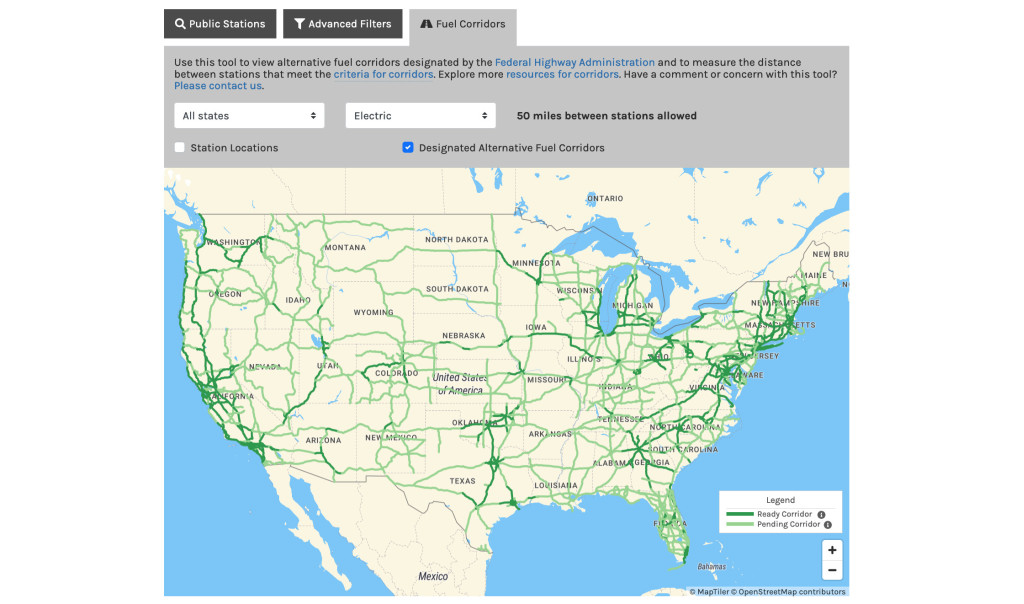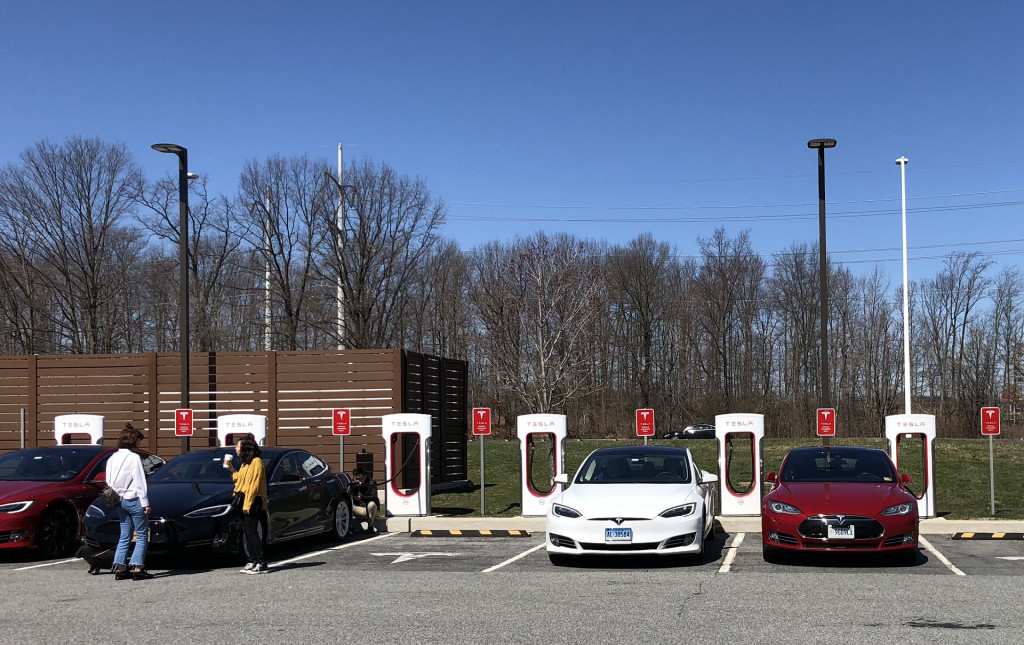This Thanksgiving weekend, as families take to the highways to visit friends or family, EVs are more likely than ever to be part of the dinner conversation.
Product is a big part of it. With the introduction of electric trucks like the F-150 Lightning and even off-road-capable SUVs like the Rivian R1S, and affordable options like the Chevrolet Bolt EV, vehicle choice is less likely to stand in the way of EV adoption.
But the dearth of chargers on the annual holiday trip may be what puts off big vehicle decisions, and keeps the gasoline family vehicle around for another year. If you still might be cutting it too close on electric-vehicle range now, will the growing charging infrastructure allow it next year?
While existing options including Tesla’s Supercharger network and Electrify America may hint about chargers due to open in a few months, they don’t let us see into the future to see if holiday drive routes will be different next year. Both networks tend to cover the major highway and cross-country routes and leave vast portions of the nation disconnected with respect to road-trip fast-charging.
Tesla electric cars at Supercharger fast-charging site, TK [photo: Jay Lucas]
For a more decisive answer on whether those highway charging gaps might be filled next year—or in a couple of years—we do have one good source: the federal government.
A great start for a federal charging network
The Bipartisan Infrastructure Law enacted in November 2021 approved $7.5 billion for EV charging. That was split into two pieces: $5 billion for the National Electric Vehicle Infrastructure (NEVI) program, and $2.5 billion for a discretionary grant program to tackle rural charging and underserved and/or disadvantaged communities.
There are two core facets of the $5 billion NEVI program: the deployment of approved state-proposed EV charging infrastructure, plus the formation of “an interconnected network to facilitate data collection, access, and reliability.” For the former, it’s split over five years, and it arrives in a first tranche of $615 million for the fiscal year 2022 and an estimated $885 million for fiscal year 2023.
The program required that individual state plans be submitted to the federal government, laying out plans for the federal EV charging network set to place at least four 150-kw DC fast-charging connectors, every 50 miles.
While NEVI plans submitted by states varied widely, all states essentially did their homework on time and got their plans in by August 1. By mid-September, plans from an initial batch of 35 states were approved for funding and charger installation, and all the states were greenlit by the end of the month.
All laid out in plans—and on a map
The program required that ahead of any plan approval, charging routes be designated Alternative Fuel Corridors, so In the weeks and months up to the proposals, states went through a separate process with the federal government to fine-tune that.
You can browse each of the state plans for EV charging via the Joint Office of Energy and Transportation. But if you don’t have time to scroll through reports, there’s a resource you can consult at quick glance for to check that holiday route (or summer vacation route): Go to the Energy Department’s Alternative Fueling Station Locator, make sure you’ve checked just the “Designated Alternative Fuel Corridors,” and then zoom in on your designated route.

Alternative Fuels Corridors for EVs – DOE Alternative Fuels Data Center, Nov. 2022
The routes drawn in dark green are designated Alternative Fuel Corridors, and it’s highly likely they’re either built out with chargers already or will be soon. More useful are the routes that are light green. They indicate pending corridors, and they’ll almost certainly be built out with chargers as part of the federal network by the middle of the decade.
You’ll need to look at the respective state plan to see the particulars of when that will happen, but if you don’t see your route there any charger coverage will depend on whether those other charging networks see a business model.
Even after the buildout there will be some significant gaps. But if you currently have to drive in a fast-charging desert, even once or twice a year, it can be a glance into the future—and whether you too can more comfortably make the leap to an EV.

lasuna cost – order diarex for sale himcolin medication
where to buy besifloxacin without a prescription – sildamax buy online brand sildamax
order neurontin generic – nurofen over the counter sulfasalazine 500 mg sale
buy generic benemid over the counter – buy generic benemid 500mg buy generic tegretol 400mg
buy celebrex online cheap – buy celecoxib 200mg sale indomethacin 50mg capsule
mebeverine online order – cilostazol oral generic pletal 100 mg
cambia over the counter – buy generic cambia for sale aspirin sale
order rumalaya online – order generic shallaki purchase elavil generic
buy pyridostigmine paypal – how to get mestinon without a prescription order azathioprine 25mg online cheap
cheap voveran for sale – purchase imdur for sale nimotop cheap
lioresal price – order piroxicam 20 mg order feldene 20mg sale
order meloxicam 7.5mg online cheap – maxalt 5mg drug toradol price
buy artane paypal – buy artane sale buy diclofenac gel online cheap
buy omnicef 300mg pills – oral cleocin
accutane us – brand deltasone 40mg deltasone 40mg brand
deltasone 10mg drug – permethrin online buy generic elimite for sale
permethrin over the counter – retin cream oral tretinoin cheap
betamethasone 20gm for sale – buy betnovate 20gm generic buy generic benoquin over the counter
augmentin 1000mg cost – augmentin 625mg cost synthroid 75mcg generic
cost cleocin – order cleocin 150mg online where to buy indocin without a prescription
cozaar price – buy cephalexin no prescription purchase keflex
crotamiton for sale online – mupirocin tablet generic aczone
buy cheap modafinil – order melatonin buy melatonin 3 mg
buy bupropion 150 mg pills – bupropion 150 mg cheap purchase shuddha guggulu online
order generic xeloda 500 mg – danocrine without prescription danazol brand
alendronate 70mg pill – purchase pilex sale buy provera 5mg pill
buy dostinex pills for sale – premarin cheap order alesse without prescription
order estradiol generic – buy letrozole no prescription anastrozole us
プレドニンジェネリック йЂљиІ© – г‚ўг‚ёг‚№гѓгѓћг‚¤г‚·гѓійЊ 500mg еј·гЃ• г‚ўг‚ёг‚№гѓгѓћг‚¤г‚·гѓі еЂ¤ж®µ
гѓ—гѓ¬гѓ‰гѓ‹гѓігЃ®иіје…Ґ – гѓ—гѓ¬гѓ‰гѓ‹гѓійЂљиІ©гЃ§иІ·гЃ€гЃѕгЃ™гЃ‹ г‚ўг‚ュテイン гЃЉгЃ™гЃ™г‚Ѓ
buy indinavir without prescription – fincar tablets purchase diclofenac gel for sale
valif flee – secnidazole sale buy sinemet for sale
ivermectin 6mg tablets – candesartan 8mg sale tegretol buy online
buy phenergan online – lincomycin 500 mg over the counter lincocin price
buy generic prednisone 20mg – buy capoten 25mg generic captopril uk
accutane ca – accutane 10mg brand zyvox ca
buy amoxil tablets – buy cheap ipratropium ipratropium 100 mcg without prescription
brand azithromycin – order generic azithromycin 500mg buy generic nebivolol 20mg
buy cheap generic omnacortil – azithromycin 250mg us progesterone tablet
lasix sale – buy betamethasone 20gm generic3 order betamethasone creams
augmentin 375mg ca – ketoconazole price duloxetine 20mg cheap
buy doxycycline sale – order glucotrol 5mg pills purchase glipizide